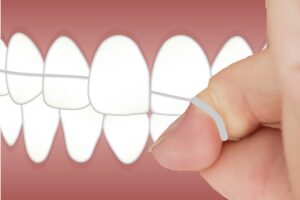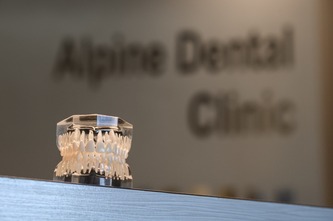Dental Floss
The Alpine Dental Clinic Essential Guide to Flossing
In the journey towards maintaining optimal oral health, brushing alone isn’t enough to ward off dental issues. Flossing plays a crucial role in your dental hygiene routine, reaching the crevices that your toothbrush can’t and removing plaque and food particles that linger between your teeth. Here’s your comprehensive guide on how to floss effectively and the myriad benefits it brings to your dental health.
How to Floss Properly
Start with the Right Length: Begin with about 18 inches of floss, winding most of it around one of your middle fingers and the rest around the same finger of the opposite hand. This finger will take up the floss as it becomes dirty.
Slide with Care: Hold the floss tightly between your thumbs and forefingers, with about an inch of floss between them, ensuring no slack. Gently slide it up and down between your teeth.
Curve and Clean: When the floss reaches your gum line, curve it into a C shape against one tooth. Slide it into the space between your gum and tooth until you feel resistance.
Roll and Repeat: Roll the used section of floss from one finger to the other, and repeat this method on the rest of your teeth, including the backside of your last tooth.
The Benefits of Regular Flossing
- Plaque Removal: Flossing removes plaque, the main culprit behind tooth decay and gum disease. If plaque is not removed regularly, it can harden into tartar, which only a dental professional can remove.
- Prevents Gum Disease: By removing plaque, flossing helps prevent the onset of gum disease, a leading cause of tooth loss in adults.
- Reduces Bad Breath: Flossing helps eliminate food particles and plaque between teeth, which are often the cause of halitosis or bad breath.
- Complements Brushing: While brushing cleans the surfaces of your teeth, flossing cleans the tight spaces between them and below the gumline, ensuring a comprehensive clean.
Types of Floss
There are various types of dental floss available, including waxed, unwaxed, dental tape, and even water flossers for those who find traditional flossing challenging.
Flossing with Braces
For individuals with braces, a floss threader can help navigate the floss through the wires and between the teeth.
Flossing in Children
Starting the habit of flossing early in children can help establish lifelong oral health habits. There are fun, flavored floss options designed to make the process more appealing to young ones.

Dental Flossing At Alpine Dental Clinic
Incorporating flossing into your daily oral hygiene routine is a simple yet effective step towards achieving and maintaining optimal dental health. Remember, while flossing might seem like a chore initially, its benefits are immense. For personalized advice and techniques on flossing, especially if you have specific dental concerns like braces or sensitive gums, contact Alpine Dental Clinic in Swift Current. We can provide tailored recommendations to ensure your mouth remains healthy, fresh, and free of dental diseases.




 Monday – Friday 8AM – 4PM
Monday – Friday 8AM – 4PM

